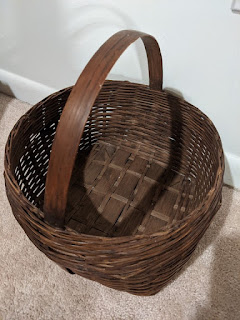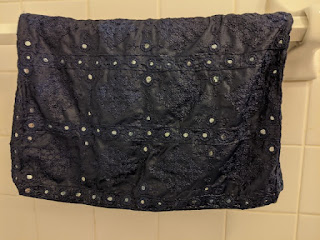The Inspiration
Thrift stores are filled with well made old business attire, things like suite and jackets or blazers. In some cases you can find items made of 100% wool (except for linings which tend to be polyester, acetate, or something similar). Those of you who have lived in cold climates might have more experience with the benefits of wool, but it really is an amazing fiber. In a world full of synthetics that break down but don't biodegrade, maybe it is time to look back to the classics - wool, linen, and other natural fibers.
For this project I was looking to make my own wool yarn. There is looooots of cheap yarn out there, but most of it is acrylic, and to me acrylic yarns feel sort of plastic-y. Wool yarns exist but are not always available at the desired price point at your local craft store. All this to say that I decided to make my own wool yarn, and as my "raw material" I used an old wool blazer from the thrift store in a beautiful dark burgundy color.
The DIY Wool Yarn From an Old Blazer Method
Step 1. Find a 100% wool garment and remove any non-wool lining.
It has to be 100% wool, if it is blended with any other fiber it will not shrink and felt properly. If an item is not labeled properly you can always try to felt it and see how it goes, but be prepared for lack of shrinkage! This happened to me recently with a name brand sweater (purchased at the thrift store) that was labeled as 100% wool. It did shrink a little, but did not fully felt, so I suspect there was some sort of stretchy fiber in the blend. Removing the lining can be done in many ways, you can either cut the lining fabric close to where it meets the wool fabric, or you can use a seam ripper to cut the thread holding them together.
Step 2. Wash your garment in hot water with a long agitation cycle.
Depending on how your original garment was dyed, the color may run. Plan accordingly. If you are not sure whether a garment is color-fast, wash it alone. Once the washing cycle is done you should see that the garment has shrunk (sometimes significantly). If it doesn't look felted, you can wash it again in a hot cycle.
Step 3. Dry your garment in a dryer with hot air.
I've seen suggestions for including a tennis ball or other items to help with the felting process, but I've never used them. If you forgot to detach the non-wool lining you should notice that it seems larger than the wool pieces by now.
Step 4. If you garment has felted, but not fully, repeat steps 2 and 3. If your garment has felted to the point where you can't see the warp and weft properly it's ready to cut.
Step 5. Decide how thick you want your wool yard, and if you want many short straight strands, or one continuous piece with a few curves in it. I chose to make one long piece of yarn from the entire sleeve of a jacket. If you want to trace out a pattern, use a marking pencil that will remain visible on your fabric.
 |
| Felted fabric and supplies |
Step 6. Start cutting! I chose to free-hand cut the sleeve, starting at the outside edge and working around the outside towards the inside like a spiral. I tried to keep the width of the 'yarn' to approximately 1/4 wide. There were a few places where I had to trim off an extra corner because I was trying to avoid sharp curves.
 |
| Cutting the felted fabric, spiral from the outside |
Step 7. Examine your completed yarn string. Trim off any excess or rough edges that bother you.
 |
| All cut up and nowhere to go |
Step 8. Wind your new yarn up into a ball so it doesn't get tangled. It is now ready to use!
 |
| Ball of yarn, ready to be reborn! |
Conclusion
This DIY wool yarn from a felted blazer method yields yarn is is wide and flat, not round. If you want to have yarn that is closer to being 'round' you could cut a narrower width - which would take longer.
Happy freestyling, don't be afraid to reuse and remake!



















































